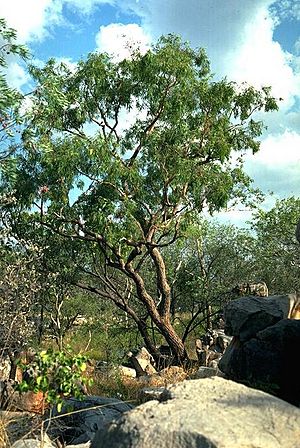Bundah bundah facts for kids
Quick facts for kids Bundah bundah |
|
|---|---|
 |
|
| Scientific classification | |
| Genus: |
Corymbia
|
| Species: |
arenaria
|
| Synonyms | |
|
Eucalyptus areanaria Blakely |
|
The Corymbia arenaria, often called bundah bundah or black bloodwood, is a unique tree. It grows only in the northern Kimberley region of Western Australia. This tree has rough bark on its trunk and branches. Its adult leaves are shaped like spears or are slightly curved. It produces flower buds in groups of seven, which open into white flowers. Later, it grows round, urn-shaped fruits.
What the Bundah Bundah Tree Looks Like
The Corymbia arenaria is a tree that can grow from 4 m (13 ft) to 15 m (49 ft) tall. It has a special woody swelling at its base called a lignotuber. This helps the tree regrow if it gets damaged, for example, by a bushfire.
Its bark is rough and brownish. It can look cracked, like a puzzle, or be flaky and crumbly on both the trunk and branches.
Young plants and new shoots have broad, spear-shaped leaves. These leaves are usually 90 mm (3.5 in) to 180 mm (7.1 in) long and 18 mm (0.71 in) to 40 mm (1.6 in) wide. The smaller branches are smooth and red.
The adult leaves grow in an alternating pattern along the branches. They are a dull green or greyish color. These leaves are typically 60 mm (2.4 in) to 160 mm (6.3 in) long and 8 mm (0.31 in) to 30 mm (1.2 in) wide. They narrow down to a stalk, called a petiole, which is 6 mm (0.24 in) to 20 mm (0.79 in) long.
The tree's flower buds grow on a branched stem, called a peduncle. Each branch holds a group of seven buds. These buds sit on small stalks, known as pedicels, which are 1 mm (0.039 in) to 6 mm (0.24 in) long.
When the buds are ready to open, they are shaped like a pear or an oval. They are about 4 mm (0.16 in) long and 3 mm (0.12 in) wide. Each bud has a rounded or cone-shaped cap, called an operculum, which falls off when the flower blooms.
The bundah bundah tree usually flowers in January or June. Its flowers are white. After flowering, the tree produces woody, round, urn-shaped fruits. These fruits, also called capsules, are 8 mm (0.31 in) to 13 mm (0.51 in) long and 7 mm (0.28 in) to 13 mm (0.51 in) wide. The seeds inside are reddish-brown and can be boat-shaped, oval, or elliptical, often with a small wing on one end.
How the Bundah Bundah Got Its Name
The bundah bundah tree was first officially described in 1934 by a botanist named William Blakely. He wrote about it in his book A Key to the Eucalypts. The information came from samples collected by Charles Gardner near the King Edward River in 1921.
Later, in 1995, two other botanists, Ken Hill and Lawrie Johnson, changed the tree's scientific name to Corymbia arenaria.
The second part of its scientific name, arenaria, comes from a Latin word. Arenarius means "growing on sand." This name was chosen because Charles Gardner noted that the tree grew in sandy areas.
Where the Bundah Bundah Lives
The Corymbia arenaria tree is found along the northern coast of the Kimberley region in Western Australia. It grows in places like plateaus (flat areas of high land), ridges (long, narrow raised sections of land), and at the bottom of cliffs. It prefers shallow sandy soils that are found over sandstone rock.

